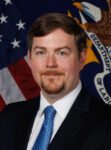MSHA Chief Says New Silica Rule is Personal

April 24, 2024 - U.S. Assistant Secretary for Mine Safety Chris Williamson says the recently approved changes to the silica dust rules in U.S. mines was one of his greatest goals when he took the job.

Chris Williamson
Williamson is a native of Mingo County and said, like most in West Virginia, he grew up watching longtime coal miners struggle for their next breath.
“Coal is the economy and it’s a big deal in southern West Virginia, but when mines aren’t safe and dust levels aren’t controlled, you see the human toll that it takes on your family members and on your neighbors, even my great grandfather had black lung disease,” Williamson, who leads MSHA, said in a recent conversation with MetroNews.
Williamson was even more adamant about pressing for the change when it was revealed the impact of dust is showing up earlier and earlier in the careers of coal miners. He noted one miner who was part of the research for the new rules was only 34 and already diagnosed with black lung.
“Not only are we seeing more disease, we’re seeing more severe forms of it. He’s 34-years old and he’s already disabled. They’re entirely preventable, but once you do that damage, it is irreversible,” he said.
MSHA’s former standard for metal/nonmetal (MNM) mines is 100 micrograms per cubic meter of air for a full-shift exposure. That means an eight-hour time weighted average. For coal mines, there was previously no separate standard for silica dust. The agency’s new standard on silica would match the Occupational Safety and Health Administration standard adopted in 2016: for both MNM and coal mines. It cuts the old standard in half to 50 micrograms per cubic meter for a full-shift exposure.
DOL Acting Secretary Julie Su speaks about the new rule at an event earlier this month. At the table are (from left) Dave Dayton, Gary Hairston, United Steelworkers VP Kevin Mapp, Cecil Roberts and Chris Williamson. David Beard/The Dominion Post
“I don’t know that folks fully appreciate it because before, there was not a separate, citable silica standard in coal mining. That meant if there was a silica over exposure, MSHA couldn’t issue a citation, MSHA couldn’t give a penalty, and we couldn’t require the mine operator to take corrective actions,” he said.
That has now all changed and MSHA will enforce the new standards which are now in effect. However, enforcement according to Williamson, will be phased in over the next year. He said the agency is working with miners and with coal operators to make adjustments and bring mines into compliance with the new standards.
“We want to work with everybody and we hope everybody really takes this as an opportunity to see we have a problem here. We have young people who are already disabled and that’s a big deal. Our agency is ready to work with anybody,” he said.
Williamson called it “unconscionable” prior to the change every other worker in the nation had better protection from silica than miners, despite miners work at the very source of the dust and where it’s cut and produced. Although Williamson’s conversations in West Virginia deal with coal mining, the new rule affects all forms of mining nationwide and will offer a greater degree of protection in those industries as well.
“I think any operator who makes it clear to their employees and their potential employees we prioritize and it’s our organizational culture to prioritize safety and health is probably going to be able to draw employees a little easier than others,” Williamson said.

